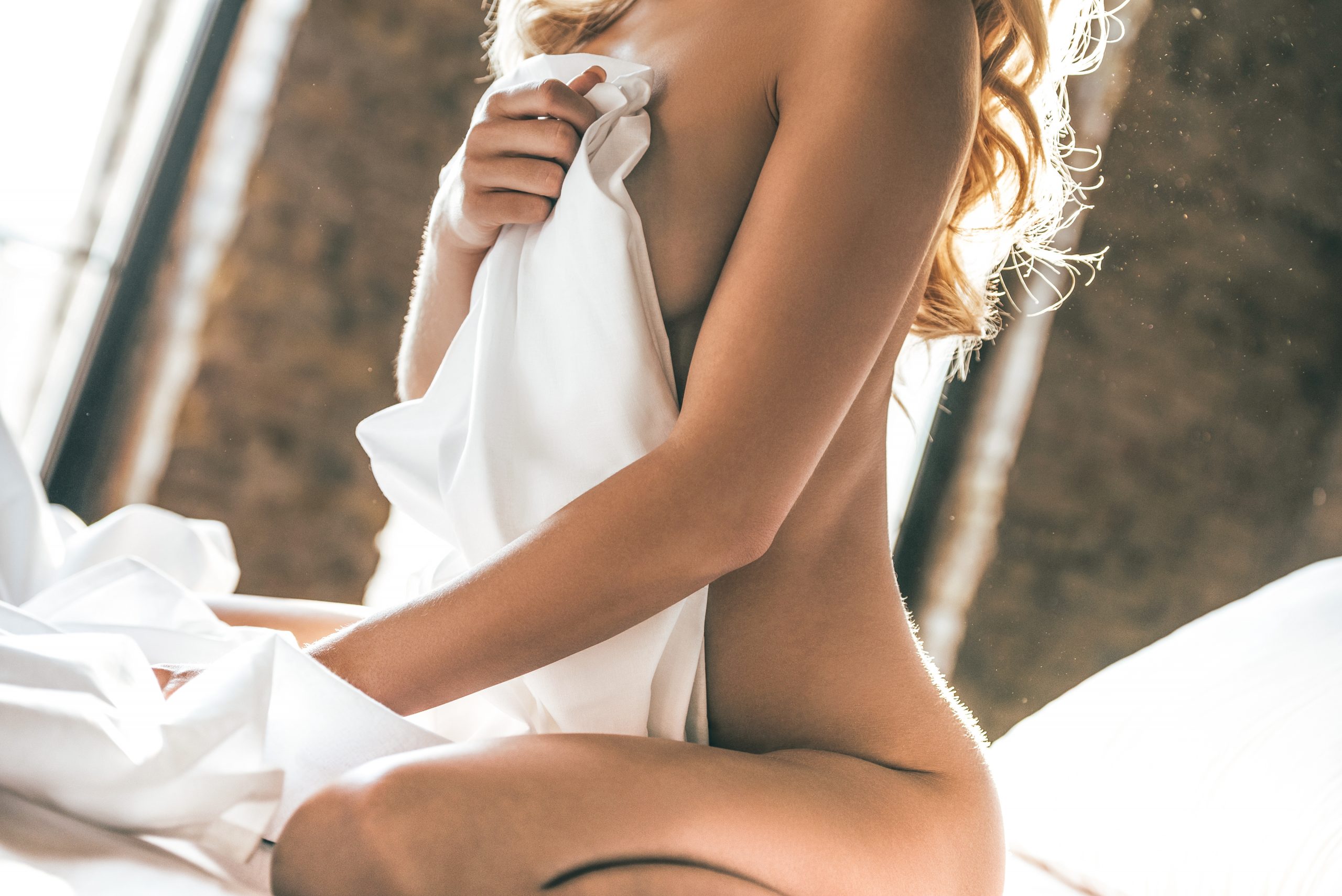
Just naked? Not anymore. We’re becoming prudish

We’re becoming prudish. Though it once was customary in parts of Europe to lie on the beach without our tops twenty years ago, you’ll now have difficulty finding any topless woman near the ocean. We even shower in our underwear after working out and TV shows like Dutch ‘Gewoon.Bloot.’ lead to intense discussion. What’s going on?
Controversy surrounding nudity on television
The Dutch television programme ‘Gewoon.Bloot.’ caused quite a bit of controversy. In the show, ten eleven- and twelve-year-olds were able to ask anything and everything of five adult guests each week. The adults were nude, which immediately caused a tidal wave of criticism. The hyper-conservative SGP party raised concerns about this in the Dutch parliament. Terms such as immoral, disgusting, and pedophilia peppered social media and people started a petition to cancel the programme.
However, the only thing the programme set out to do is make nudity a topic that could be discussed openly so children could see that everyone’s body is different and nothing to be ashamed about. Of course, the children were a bit awkward and giggly at first, but they soon asked more serious questions and essential topics became the subject of discussion. For instance, they asked about the changes bodies go through as we age.
Nude = sex?
The issue is that the people opposing the program think of nudity as being synonymous with sex, but being naked doesn’t necessarily mean sex is on the agenda. After all, you’re naked whenever you get into the shower or change your clothes. Getting to know your body, not being ashamed of your body, and realising everybody’s body is different has nothing to do with sex.
Social researcher Linda Duits brings up the example of the recurring discussions about primary school girls wearing hotpants in the online magazine ‘IJzeren Eeuw’. Teachers could regard these as sexual, but maybe they’re just fashionable pieces of clothing that are nice and cool during hot summers. She notes that more and more people are equating bare skin with sex and prudishness is thus noticeaably on the rise.
The swinging of the pendulum
Things didn’t use to be like this, proponents of such programmes as ‘Gewoon.Bloot’ and nude beaches say. Especially before the turbulent sixties, we were living in a pretty prudish time, but we’ve been free ever since we gave up being forced to wear our bras. Nobody was surprised by a naked breast here or there and nobody was forced to mess about with nursing blankets and the like. At least, not until this new form of prudishness presented itself.
But is that a correct representation of the past? Were we really so ignorant and prudish before the sixties? Experts Anais Van Ertvelde and Heleen Debruyne emphasise that history is not as straightforward as that. They compare it to the swinging of a pendulum, where times of prudishness alternate with times of (sexual) liberty. To prove this, they pointed to a hymn about the vagina from the fifteenth century and to the fact that people in the Middle Ages already knew the clitoris was bigger than just a ‘button’, something our grandparents needed to rediscover again.
Greek gymnasts
The pendulum has swung many times when it comes to prudishness over the ages. For instance, nudity was rather normal in the time of the ancient Greeks. Young men played sports completely naked in the gymnasium and many athletes showed up naked for the Olympics Games. By doing so, they showed the gods and spectators alike how athletic and strong their bodies were.
Influenced by Christianity, taboos surrounding nudity began to arise, perhaps informed by the story of Adam and Eve’s discovery that they were naked. After they ate the forbidden fruit, they became ashamed of their nudity and covered themselves with fig leaves.
However, naked bodies weren’t seen as offensive in the daily lives of ordinary people from the Middle Ages. Many people swam and slept in the nude and, according to art historian Jan de Jong, a bit of nudity here and there was nothing to freak out about. Despite the church’s strict rules surrounding sexuality, society was rife with dirty books, songs and plays.
Liberal morality
After the Middle Ages, the Renaissance marked a comeback of male nudity in art. Sculptors and painters looked back at the art from the Greek and Romain periods and saw lots of naked penises and breasts. But it was also the age of the Reformation and and a push to suppress the sex scandals happening within the church. A wave of morality engulfed society which was visible in the chaste fig leaves that were added to many sets of genitals of marble statuary.
The prudish fog cleared up a bit in the seventeenth century, especially in the Netherlands, where a liberal sexual morality reigned. The Dutch would kiss in public, use “spicy” language and surprise foreigners with their openness. A common occurrence was ‘kweesten’, where unmarried young people around twenty years of age could kiss and caress each other. When it was made clear they would also marry each other, they were allowed to sleep together as well. Around that time, ‘suitor books’ appeared as well, in which the art of seduction and a variety of sexual positions were explained.
Victorian table legs
However, in the nineteenth century, prudishness made its return. This era is called the Victorian Era and was marked by a spirit of conservatism and strict standards of decency. Women were expected to be chaste and pious and not know much about sex, pregnancy, or giving birth. A different set of morals applied to men, of course. As long as they didn’t go about it in public, men were free to indulge in all kinds of sexual excesses in brothels.
All expressions of sexuality and eroticism in public life were prohibited. Even table legs were covered with tablecloths because they were thought to closely resemble women’s legs. And, in art, only mythological creatures were allowed to be depicted nude.
However, according to historian Peter Gay, things weren’t as prudish or rigid back then as we might think. Victorian society was also rife with brothels, pornographic imagery and extramarital relations, although it was all done behind closed doors,especially for women, as Anais Van Ertvelde emphasizes. The Victorian woman had to be a ‘tender, domestic and motherly figure’, that only had sex to please her husband, with no regard for her own sexuality. Female lust? That didn’t exist because it was considered indecent.
Naked at Woodstock
In the twentieth century, sexual morals loosened up again, with a slight dip seen in the bourgeoisie-filled fifties. However, in the sixties, things really began to take off. The influence of self-righteous churches began to decline, the second wave of feminism hit and the sexual revolution began. Even in the Netherlands, people could notice the skirts getting shorter. In 1967, Phil Bloom was the first woman to appear on national television completely nude, which led to a discussion in parliament and caused a stir worldwide.
The Netherlands solidified its image as a liberal country in the following years and many television programmes about nudity and sexuality followed. People went on nudist vacations and the beaches were packed with topless women without anybody so much as batting an eye. Images of naked hippies in the Vondelpark could be seen worldwide. One year, the election posters for the PSP, a pacifist political party, depicted a naked woman next to a cow.
Under the influence of the flower child generation, public nudity became normal. The naked human body came tos stand for innocence, nature and freedom. People danced naked at Woodstock, had open relationships and experimented with sex and different partners. No longer was the naked body seen as something to be embarrassed about, and instead, it was something to be celebrated.

Prudishness versus pornification
Over the past couple of years, things have become increasingly prudish and maybe that is to be expected in a society where ‘just being naked’ has become less and less common. No woman wants to lay on the beach topless anymore and breastfeeding in public and being naked in a sauna are becoming less common as well. There are now more swimwear-required days in saunas as well.
Nowadays, young people also tend to have sex later in life, feel like sex is something exclusive to relationships, and don’t experiment as much with different partners. Making out in public and especially for homosexuals? More and more people find this offensive and unnecessary these days. ‘Everything needs to be behind closed doors again’, Linda Duits said on ‘IJzeren Eeuw’. She wonders whether or not the sexual revolution of the 60s was really a revolution at all and not just one of the many pendulum swings that have always characterised society’s attitudes towards sex.
Pursed lips
At the same time, there has been a sharp rise of sexual and nude images in film and TV, as Inger Leemans argues in the same article. We’re bombarded with ‘pornographic nudity’, images of tight and so-called perfect bodies in sexually provocative positions. The alarm bells ring when children play ‘doctor’, yet we don’t bat an eye when they post hundreds of suggestive pictures of themselves with pursed lips on Instagram or TikTok.
Luckily, every movement has a counter-movement. Look at hopeful series such as Sex Education, which depicts sex and naked bodies normally and naturally. It is a series that teaches young people and adults alike that it’s all just normal, no matter your body type or sexual orientation.
#FreeTheNipple
The movement to liberate the female nipple on social media also fits in with this trend. With the hashtag FreeTheNipple, female celebrities are trying to normalise showing naked breasts on social media. They shine a light on the double standard where male nipples are allowed to be shown, but female nipples get removed because they can cause offence and are seen as sexual, even if moment a baby is nursing on the nipple.
Well, these are paradoxical times we live in. On the one hand, there is the increasing prudishness, and on the other hand, there is pornification. Let’s hope for further normalisation of nudity and the uniqueness of the human body before we all end up thinking that photoshopped and tight bodies on social media are the norm.








Respond or ask a question
0 comments